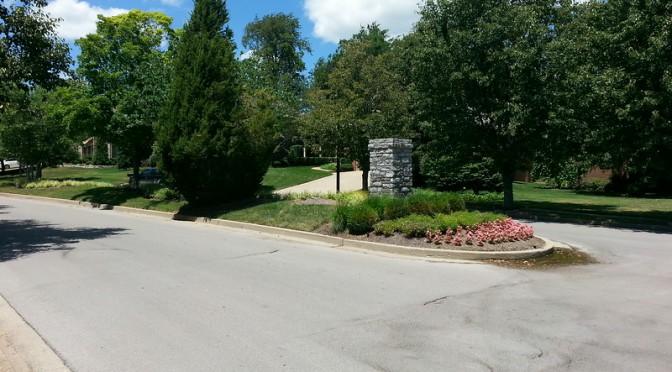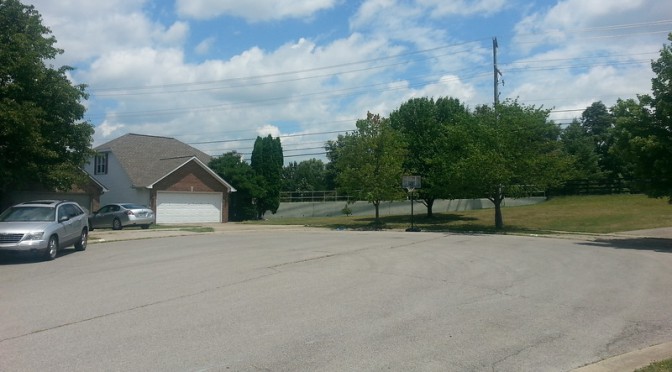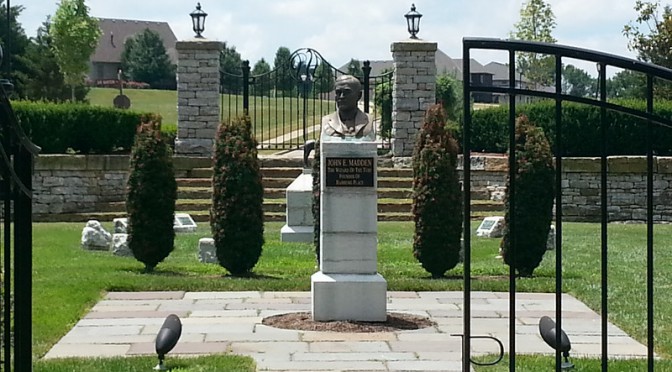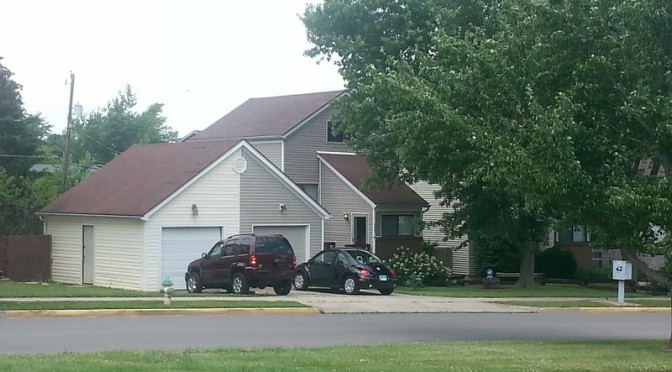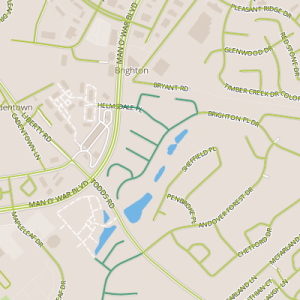 Today, I walked through the Andover Forest neighborhood, adjacent to Man O’ War at Todd’s road. Similar to Forest Hills walk on Day 8, these houses are probably from the same time and indeed, many of them have similar decorative keystones. The houses are larger here and perhaps unique from all the other neighborhoods I’ve visited thus far, nary a blade of grass was out of place. In fact, there was a variety of gardening techniques, though all seemed to leave at least some grassy areas intact. Another notable aspect of the lots here is that they are so large there are long moments where it can feel as if you’re in a particularly well-cared for park. One of the more interesting aspects of the sidewalk in this area is at the entrance to the neighborhood, which, instead of following the street, winds upward and through an archway, lending the path an air of mystery. This was the kind of thing I would really dig when I would casually explore on foot. This area has a series of ponds, so that most of the houses I passed on Brighton Place have large open space (if not the ponds themselves) visible behind them.
Today, I walked through the Andover Forest neighborhood, adjacent to Man O’ War at Todd’s road. Similar to Forest Hills walk on Day 8, these houses are probably from the same time and indeed, many of them have similar decorative keystones. The houses are larger here and perhaps unique from all the other neighborhoods I’ve visited thus far, nary a blade of grass was out of place. In fact, there was a variety of gardening techniques, though all seemed to leave at least some grassy areas intact. Another notable aspect of the lots here is that they are so large there are long moments where it can feel as if you’re in a particularly well-cared for park. One of the more interesting aspects of the sidewalk in this area is at the entrance to the neighborhood, which, instead of following the street, winds upward and through an archway, lending the path an air of mystery. This was the kind of thing I would really dig when I would casually explore on foot. This area has a series of ponds, so that most of the houses I passed on Brighton Place have large open space (if not the ponds themselves) visible behind them.
Tag Archives: 40509
Day 8
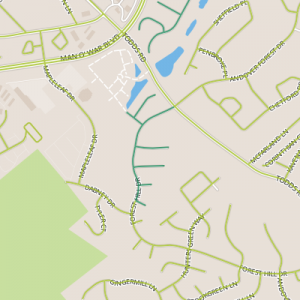 Today’s walk was through a mostly 1990’s vintage subdivision outside of Man O’War at Todd’s Road. The area is anchored by a large property at the corner of Todds and Forest Hill Drive. I really enjoy these older properties in neighborhoods which are often surprisingly modern. Unfortunately, this one is well hidden! But the property looks neat. Something else that occurred to me was that the infrastructure issues seen on day 7 have largely been ironed out (it seems) by the time this area was built out. No cul-de-sacs over culverts here; the cul-de-sacs all end at a similar greenspace though. Prior to walking, I suspected the forested area on the perimeter was stormwater-related. But this possibility seems unlikely after viewing at eye level as the roads seem to drain away from it; the infrastructure hidden here is something different! Speaking of drainage, I noticed a number of driveways that drain toward their respective houses. This seems almost intuitively to be a bad idea but it seems common here with the slab-on-grade construction.
Today’s walk was through a mostly 1990’s vintage subdivision outside of Man O’War at Todd’s Road. The area is anchored by a large property at the corner of Todds and Forest Hill Drive. I really enjoy these older properties in neighborhoods which are often surprisingly modern. Unfortunately, this one is well hidden! But the property looks neat. Something else that occurred to me was that the infrastructure issues seen on day 7 have largely been ironed out (it seems) by the time this area was built out. No cul-de-sacs over culverts here; the cul-de-sacs all end at a similar greenspace though. Prior to walking, I suspected the forested area on the perimeter was stormwater-related. But this possibility seems unlikely after viewing at eye level as the roads seem to drain away from it; the infrastructure hidden here is something different! Speaking of drainage, I noticed a number of driveways that drain toward their respective houses. This seems almost intuitively to be a bad idea but it seems common here with the slab-on-grade construction.
I was most focused today on front yards today, hoping to see neat yard solutions. Front yards seem universally kind of…neglected. They are mowed (or not) but largely they seem to be a patch of grass with no real reason for being. Of course, homeowners associations will limit the breadth of things that can be done. But I do expect to see some interesting things, especially in “covenant controlled” neighborhoods like my own. I think we can do better.
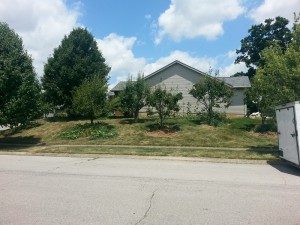
And I do see, in maybe one or two houses per mile or two I walk each day, really well-landscaped yards that I suspect take quite a bit of work and or artistry. These yards are nice, of course, but I’d really like to see the aesthetically not-bland yard for the rest of us.
Today’s walk did reveal a pretty earnest front yard garden with tomatoes, melons and some other vines that were generally kept inside the mulch ring around their trees (as much as you can restrict a zucchini plant, anyway).
Day 4
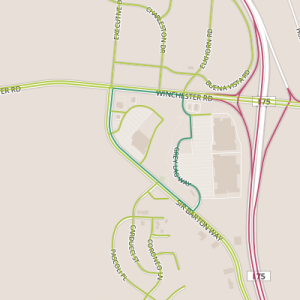 Today’s walk provides a lot of support that my motivation for walking every street to find the hidden gems is in fact worthwhile. Certainly, I expect that some walks are not going to be terribly interesting, and I scheduled a pilot walk in Hamburg including part of it’s northern boundary on Winchester Road simply to see how bad it would be. Instead, I turned out some of the most interesting things to date.
Today’s walk provides a lot of support that my motivation for walking every street to find the hidden gems is in fact worthwhile. Certainly, I expect that some walks are not going to be terribly interesting, and I scheduled a pilot walk in Hamburg including part of it’s northern boundary on Winchester Road simply to see how bad it would be. Instead, I turned out some of the most interesting things to date.
I parked in a far corner of a parking lot and headed towards Sir Barton, then along Winchester Road, basically along a culvert. Nearing Grey Lag, I saw a sidewalk appear, leading from the shopping area along Sir Barton and Winchester to a park in the middle of the block. If one slipped off the path, however, you would discover a trail leading into the woods.

Following the trail for a short distance uncovered an old foundation wall, and the path continued from there. I headed back to my scheduled route, but found the allure of the hidden park too much to ignore, so I spent some extra time walking through it as well. I was more than a little surprised to find out that the park was centered on a horse cemetery, part of Hamburg Farms.
I headed back to my route and eventually passed the front of the horse cemetery again on the Sir Barton side, where it is clearly labeled. This may well be something that long-time Lexingtonians are well aware of, but I was surprised to find that this horse cemetery was in plain sight along a street I’ve driven down dozens of times.
I thought this walk nicely demonstrated a couple of points, one about the hidden gems of the urban fabric and another about the impact of pace on what we can allow ourselves to see in our built environment.
Day 3
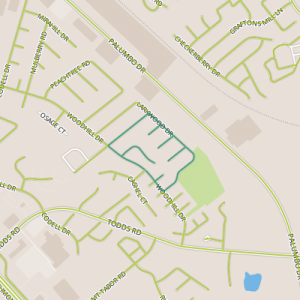 Day 3 of my pilot walking took me to the area around Woodhill Park and (much like Day 2) near the industrial corridor along the RJ Corman tracks. Today’s walk took me through portions of two distinct neighborhoods with apparently different periods of construction, though both neighborhoods were typically suburban. Today was my first experience with long cul-de-sacs, something that I’m finding are present in many of the neighborhoods built in the last five decades or so. Cul-de-sacs are an interesting problem for me as someone who is in essence just taking a stroll through a neighborhood. If I’m trying to get somewhere, I’m definitely going to avoid cul-de-sacs, but even if I’m strolling, my instinct is to avoid them because, well, it’s just awkward to walk down a street, then turn around and walk back. But this is exactly what I did, several times. today. Cul-de-sacs are intentional, a way to keep traffic and strangers off a street. They feel safe to walk on, but I think that someday, someone is going to ask me what I’m doing!
Day 3 of my pilot walking took me to the area around Woodhill Park and (much like Day 2) near the industrial corridor along the RJ Corman tracks. Today’s walk took me through portions of two distinct neighborhoods with apparently different periods of construction, though both neighborhoods were typically suburban. Today was my first experience with long cul-de-sacs, something that I’m finding are present in many of the neighborhoods built in the last five decades or so. Cul-de-sacs are an interesting problem for me as someone who is in essence just taking a stroll through a neighborhood. If I’m trying to get somewhere, I’m definitely going to avoid cul-de-sacs, but even if I’m strolling, my instinct is to avoid them because, well, it’s just awkward to walk down a street, then turn around and walk back. But this is exactly what I did, several times. today. Cul-de-sacs are intentional, a way to keep traffic and strangers off a street. They feel safe to walk on, but I think that someday, someone is going to ask me what I’m doing!
My favorite aspect of today’s walk were the set of homes along Larkwood facing the park, pairs of detached houses with combined garages.
